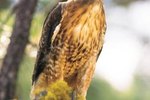
The Arabian Desert dominates much of the Arabian Peninsula. The Rub al-Khali, the largest continuous body of sand on Earth, stretches across the Arabian Desert from Jordan and Iraq to the north and Qatar and Yemen to the south. This desert eco-region is home to a variety of animals adapted for life in an arid, nearly water-free environment.
Mammals
Cape hares, sand cats, striped hyenas, red foxes, caracals, two species of gazelle and Arabian wolves, camels and oryxes live within the Arabian desert. Mammals in the desert inhabit both the region’s arid and semi-desert brush areas. One of the most recognizable mammals in the area, the Arabian camel (Camelus dromedarius), thrives by storing up to 80 pounds of fat in its single hump. These camels, also known as dromedaries, have the ability to metabolize stored fat for energy when sustenance is unavailable.
Invertebrates
Insects and arthropods permeate the Arabian Desert. Scorpions, spiders, ants, bees, wasps, moths and beetles have a long history within the region. Scarab beetles, members of the family Scarabaeoidea, consume dung and plant material and are the most numerous group of beetles in the desert. One of the largest arachnids in the Arabian Desert -- the Egyptian giant sopulgid, otherwise known as the camel spider (Galeodes arabs) -- grows up to 6 inches long and can move as fast as 10 miles per hour.
Reptiles
Snakes, lizards and geckos thrive in the Arabian Desert. More than 100 lizard species live in the region, with geckos boasting the largest variety of species. However, the largest and most famous lizard in the desert is the Egyptian uromastyx (Uromastyx aegyptia), commonly known as the dhub. These agamids grow up to 2 feet long and can weigh up to 10 pounds. Herbivores, they are commonly hunted for food. Cobras and horned vipers also inhabit the desert, though these venomous reptiles manage to avoid Saudi dinner plates.
Birds
Hundreds of avian species inhabit or pass through the Arabian Desert each year. Birds of prey like vultures, buzzards and falcons are some of the most prevalent, though they are not endemic to the area. The Lanner falcon (Falco biarmicus) is one of the oldest species of heirofalcons and is a fast, agile hunter. Swallows, martins, sparrows and doves also pepper the skies. The Namaqua dove (Oena capensis) has a light gray body and black face and underside of the neck, making him easily identifiable on bird-watching trips through the desert.
References
- Marshall Cavendish: Flora and Fauna of the Arabian Peninsula
- National Geographic: Arabian (Dromedary) Camel
- UAE Interact: Insects and Other Arthropods
- National Geographic: Egyptian Giant Solpugid
- Reptile Channel: Herping Saudi Arabia Lizards
- Avibase: Saudi Arabia
- Northwest Wildlife Online: Saudi Arabian Birds
- National Aviary: Lanner Falcon
Photo Credits
-
Hemera Technologies/AbleStock.com/Getty Images
Writer Bio
Christina Stephens is a writer from Portland, Ore. whose main areas of focus are pets and animals, travel and literature. A veterinary assistant, she taught English in South Korea and holds a BA in English with cum laude honors from Portland State University.



